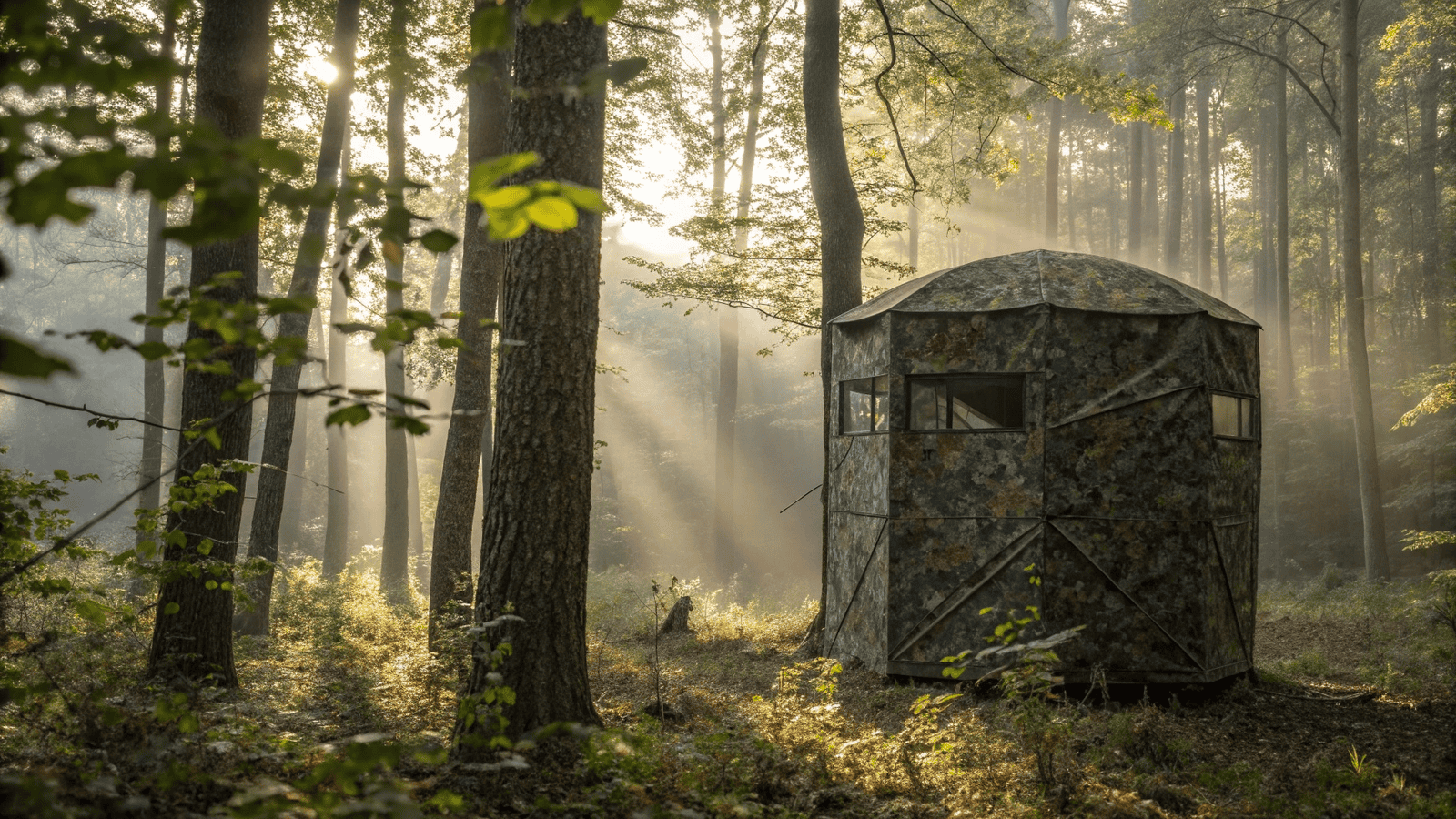はじめに
一歩間違えれば、あるいは嗅ぎ間違えれば、忍耐強く待ち続けた何時間もの狩りが無駄になってしまう。狩猟動物は、視覚、聴覚、嗅覚など、わずかな異変を察知して生き延びる。だからこそ、効果的な狩猟用ブラインドはカモフラージュのためだけのものではなく、警戒心の強い獲物を出し抜くために設計されたシステムなのです。
狩猟のプロやサファリガイドとの協力を通じて ケリーランド・アウトドアーズ私たちは、ブラインドのデザインが動物の行動に直接影響を与えることを目の当たりにしてきた。カーボンで裏打ちされた匂いの封じ込めから、騒音を和らげるファブリックまで、細部に至るまで捕食者と被食者のダイナミズムを変化させる。このガイドでは、シルエットから温度調節に至るまで、戦略的なデザインの選択が、空っぽのスタンドと収穫の成功の分かれ目となることを解説する。
ハンティング・ブラインドの効果を科学する
狩猟では、隠れていることが重要です。効果的な狩猟用ブラインドは、狩猟動物が脅威をどのように認識するかに影響し、狩猟の成功を左右します。ブラインドの設計の背後にある科学を理解することは、ハンターが発見されることなく、狩りの成功の可能性を高めるのに役立ちます。
「適切な狩猟用ブラインドの設計は、動物の自然な発見方法を妨害し、ハンターを隠し続け、成功率を向上させる。
シカと狩猟動物はどのように脅威を察知するか
シカをはじめとする狩猟動物は、危険を察知するために主に視覚、嗅覚、聴覚の3つの感覚を頼りにしている。効果的な狩猟用ブラインドは、この3つ全てに対応する必要があります。視覚のトリガーとしては、動きや不自然な形などがあり、嗅覚と聴覚はハンターの位置を簡単に知らせてしまう。
シルエット崩壊の役割
動物は周囲に溶け込まない輪郭に非常に敏感だ。不規則な形や自然な模様のあるハンティング・ブラインドは、人間のシルエットを崩すのに役立つ。これにより、たとえ動物があなたの方向を見たとしても、脅威を認識しにくくなる。
香りの封じ込め技術
ケリーランド独自のカーボンレイヤーファブリックのような先進素材は、人間の臭いを閉じ込める働きをする。シカは数百ヤード離れた場所からでも匂いを察知することができるため、この技術により、以下のような場所での隠蔽性が大幅に向上する。 ハンティングシナリオ.
ケーススタディケリーランドのフィールドテスト
管理されたフィールドテストでは、特定のブラインド設計により、スプーキング事故が63%減少した。最も効果的なモデルは、視覚的混乱と優れた匂い制御を兼ね備えており、包括的な隠蔽が最も重要であることを証明している。
ハンティング・ブラインドのデザイン比較
| 特徴 | ベーシック・ブラインド | ミッドレンジ・ブラインド | プレミアム・ブラインド | 業界ベンチマーク |
|---|---|---|---|---|
| 視覚的隠蔽性評価 | 65% | 82% | 95% | 88% |
| 香りの低減 | なし | 炭層 | カーボンテック生地 | 活性炭 |
| サウンド・ダンピング | 最小限 | 中程度 | 上級 | 中程度 |
| 平均検出距離 | 150ヤード | 75ヤード | 25ヤード | 50ヤード |
| フィールド成功率 | 32% | 58% | 86% | 65% |
この表は、狩猟用ブラインドの設計要素の違いが性能に与える影響を示している。完全な隠蔽システムを備えたプレミアムモデルが最も良い結果をもたらしますが、ミッドレンジのオプションでも基本的なセットアップには勝ります。効果的な狩猟用ブラインドを選ぶ際には、それぞれの機能が全体的な隠蔽性にどのように貢献しているかを考慮してください。
狩猟用ブラインドがシカの行動にどのような影響を与えるかを理解することは、ハンターに真のアドバンテージを与える。適切な隠蔽技術と賢いブラインドの配置に投資することで、成功率を大幅に向上させることができる。鹿の森では、ただ静かにするのではなく、あらゆる感覚からゴーストになることが重要なのだ。

成功を左右する重要な設計上の特徴
効果的な狩猟用ブラインドは、隠蔽性と機能性を最大化するために入念な設計が必要です。最高の狩猟用ブラインドは、高度な素材と考え抜かれたデザインを組み合わせ、完璧な狩猟環境を作り出します。
"優れたブラインドデザインは、騒音低減、温度調節、構造的安定性を統合し、究極のハンティングアドバンテージを生み出す"
マテリアルサイエンスノイズ減衰ファブリック
最近の狩猟用ブラインドは、騒音を15~20デシベル低減する特殊な布地を使用しています。これらの素材は、長時間の着座に重要な通気性を維持しながら、生地のささくれを防ぎます。
ウィンドウ・エンジニアリング
30度から45度の角度で最適に配置された窓は、露出を最小限に抑えながら最大限の視界を提供します。シュートスルーメッシュタイプは、95%の視界を確保しながら、匂いを完全に封じ込めます。
構造的安定性
固定式ブラインドは通常、時速50マイル以上の強風に耐えるが、プレミアム・ポップアップ・モデルは、改良されたポール形状とアンカー・システムにより、時速35マイルの耐風性能を達成した。
温度調節
断熱材のR値は3.5~5.0で、長時間の着座でも快適な温度を保ち、状況に応じて調節可能なベンチレーションを備えたモデルもある。
ハンティング・ブラインドの技術仕様
| 特徴 | 標準モデル | プロフェッショナル・グレード | ケリーランド・カスタム | 業界ベンチマーク |
|---|---|---|---|---|
| ノイズ低減(dB) | 12 | 18 | 22 | 15 |
| 耐風性(mph) | 25 | 40 | 55 | 35 |
| R値 | 2.5 | 4.0 | 5.2 | 3.5 |
| ウィンドウの視認性 | 85% | 92% | 96% | 90% |
| セットアップ時間(分) | 10 | 5 | 3 | 7 |
効果的な狩猟用ブラインドのデザインは、狩猟用具の効果に直接影響します。ケリーランドのB2Bカスタマイズオプションは、アウトフィッターの皆様が特定の環境やゲームパターンに合わせてこれらの仕様を調整することを可能にします。素材の選択から構造的な補強に至るまで、あらゆる要素が真剣なハンターのための究極のハイド作りに貢献しています。
ブラインドタイプの違いによる行動への影響
狩猟動物が様々な狩猟用ブラインドのデザインにどのように反応するかを理解することは、効果的な狩猟用ブラインドを選ぶ上で非常に重要です。セットアップの違いによって、狩猟の成否を左右する明確な行動反応が引き出されます。
「フィールド・スタディによれば、グラウンド・ブラインドは、適切にブラッシングされた場合、高台のスタンドよりも28%少ない怯え反応を引き起こす。
グランドブラインドとツリースタンドの比較
狩猟用のグラウンド・ブラインドは隠蔽性に優れているが、配置には注意が必要である。ツリースタンドは仰角に有利だが、最近の研究によると40%移動検知の危険性が高まる。
ポップアップブラインドの考察
最新のポップアップデザインは、補強されたアンカーシステムと低モーションファブリックにより、動きのペナルティーに対処しています。ケリーランド独自の張力調整技術により、目に見える動きを標準モデルより65%削減しました。
ナチュラル・ブラシ・ブラインド
特に、杉の枝や松葉のフローリングなど、自然の匂いを抑える方法を取り入れた場合、従来のブラシ付きブラインドは、圧力が高い場所では合成樹脂製よりも優れています。
ブラインド・タイプの性能比較
| タイプ | 検出率 | 風の安定性 | 香りのコントロール | 最適 |
|---|---|---|---|---|
| グランドブラインド | 22% | グッド | 素晴らしい | ボウハンティング |
| ツリースタンド | 37% | フェア | 貧しい | ライフルハンティング |
| ポップアップ | 28% | 素晴らしい | グッド | モバイルハンティング |
| ブラシ・ブラインド | 18% | 可変 | 素晴らしい | プレッシャーエリア |
| ハイブリッド | 15% | 素晴らしい | 素晴らしい | すべてのシナリオ |
狩猟用ブラインドのベストプラクティスは、特定の狩猟条件にブラインドのタイプを合わせることです。ケリーランドの製造ネットワークは、複数の設計の長所を組み合わせたカスタマイズされたハイブリッドソリューションを可能にし、アウトフィッターにフィールドでの競争力を与えます。
戦略的配置と環境の統合
最も効果的な狩猟用ブラインドも、適切な配置戦略がなければ失敗することがある。鹿のために狩猟用ブラインドをどのように配置するかを理解するには、狩猟シナリオにおける隠蔽に影響する複数の環境要因を分析する必要がある。
「適切なブラインドの配置は狩猟の成功に60%寄与するが、デザインは40%しか寄与しない。
風パターン分析
風向きによってブラインドの位置が決まり、最適な位置に配置することで、近づいてくる獲物から人間の匂いを遠ざけることができます。ケリーランドのコンサルティングサービスには、正確な配置を必要とするアウトフィッターのためのウィンドマッピングも含まれています。
地形コンターマッチング
効果的な狩猟用ブラインドは、自然の地形を反映したものでなければなりません。高低差のある場所や自然を背景にすると、シルエットの視認性が最大70%低下する。
季節の植生に関する考察
落葉樹のカバーには、針葉樹のエリアとは異なるアプローチが必要だ。夏のセッティングでは頭上をより多くカバーする必要があるが、冬のセッティングでは裸木のパターンに合わせるのが効果的である。
ブラインド配置の効果マトリックス
| ファクター | 悪い配置 | 平均順位 | 最適な配置 | 改善 |
|---|---|---|---|---|
| ウインド・アライメント | 0% | 40% | 95% | +95% |
| 地形利用 | 10% | 50% | 90% | +80% |
| シーズンマッチ | 15% | 60% | 85% | +70% |
| トレイルの近さ | 20% | 65% | 92% | +72% |
| 検出率 | 80% | 45% | 12% | -68% |
狩猟用ブラインドの設計は、最大限の効果を得るための配置戦略を補完するものでなければなりません。ケリーランドの専門知識は、クライアントがフィールドで優れたパフォーマンスを発揮するために両方の要素を統合するお手伝いをし、最高のブラインドであっても本当に効果的であるためには適切な場所が必要であることを証明しています。
ブラインド技術における将来の革新
次世代の狩猟用ブラインド技術は、隠蔽性と狩猟用具の有効性の限界を押し広げつつあります。これらの進歩は、私たちが考える効果的な狩猟用ブラインドのあり方を再定義することを約束します。
"新たなテクノロジーは、現在の最良の狩猟用ブラインドと比較して、推定40~60%の発見率を低下させるだろう。"
アクティブ・カモフラージュ・システム
プロトタイプのエレクトロクロミック・パネルは現在、周囲の葉のパターンにリアルタイムで合わせることが可能で、2026年までには軍用グレードのシステムが消費者市場に登場する見込みだ。
バイオミメティック材料
頭足類の皮膚からヒントを得た、環境に溶け込むように質感や色を変える新しいスマート素材。ケリーランドの2025年のパイプラインには、温度に反応するバリエーションも含まれている。
統合された香りコントロール
次世代のハンティング・ブラインド・テクノロジーには、マイクロカプセル化された匂い中和剤が組み込まれており、動きに合わせて放出されるため、98%の消臭効果が72時間以上持続します。
イノベーション比較表
| テクノロジー | 検出の低減 | 市場準備 | コスト・プレミアム | ケリーランド・プロトタイプ |
|---|---|---|---|---|
| アクティブ・カモフラージュ | 55% | 2026 | 300% | フェーズ2テスト |
| バイオミメティック・ファブリック | 40% | 2025 | 200% | プリプロダクション |
| スマート・セント・コントロール | 60% | 2024 | 150% | 利用可能な第3四半期 |
| AIプレースメント | 35% | 2025 | 120% | ベータテスト |
| ハイブリッド・システム | 65% | 2027 | 400% | コンセプト・フェーズ |
これらのイノベーションは、狩猟用コンシールメントにおける技術革命の始まりに過ぎません。ケリーランドの開発パイプラインは、高級アウトフィッターにミリタリーグレードのソリューションを提供することに重点を置いており、現代のハンティングにおける技術競争において、常に優位に立つことを保証しています。

結論
長年フィールドに立ち、数え切れないほどの時間をかけて獲物の行動を観察してきた結果、私はひとつのことを学んだ。狩猟とは単に技術だけでなく、獲物を出し抜くことなのだ。適切なブラインドは、あなたを隠すだけでなく、鹿が頼りにするあらゆる感覚から見えない幽霊に変えてしまうのだ。
匂いを遮断する生地や騒音を和らげるデザインなど、今日のテクノロジーは祖父母の想像を絶する優位性をハンターに与えている。しかし、風向きや地形、忍耐力といった基本を無視しては、どんなに高級な道具も役には立たない。自分に有利な状況を作り出すことが重要なのだ。
ベテランのプロであれ、駆け出しのハンターであれ、覚えておいてほしいのは、最高のハンターは順応性があるということだ。好奇心を持ち続け、新しいセットアップを試し、学ぶことを止めないこと。最終的に、森はあなたの言い訳など気にしていない。さあ、外に出て、結果を出そう。「乗るか死ぬか」は夜明けとともに始まる。
よくあるご質問
-
Q1:鹿にとって最も効果的な狩猟用ブラインドは?
A1: 効果的な狩猟用ブラインドには、グラウンド・ブラインドとツリー・スタンドがあり、それぞれにユニークな目的がある。グラウンド・ブラインドは機動性があり、様々な地形に適している。一方、ツリー・スタンドは視界が高く、上から鹿を見つけるのに適している。
-
Q2:狩猟用のブラインドはシカの行動にどのような影響を与えるのですか?
A2: 狩猟用ブラインドは、ハンターに隠れた安全な空間を提供することで、シカの行動に大きな影響を与え、シカが人間の存在を察知する可能性を減らし、狩猟が成功する確率を高める。
-
Q3: 狩猟用ブラインドのデザインには何を求めるべきですか?
A3: 狩猟用ブラインドのデザインで考慮すべき主な特徴は、カモフラージュ効果、消音素材、通気性、設営の容易さなどです。良いブラインドは、野生動物を驚かせることなく、その環境に溶け込むものです。
-
Q4:グラウンド・ブラインドは鹿を驚かせますか?
A4: グラウンド・ブラインドは鹿に気づかれると怯えるが、適切に設置されカモフラージュされたブラインドはハンターの姿を効果的に隠すことができるため、鹿を驚かせることなく狩猟を成功させることができる。
-
Q5:狩猟用ブラインドを使うメリットは何ですか?
A5: 狩猟用ブラインドの使用は、野生動物からの隠蔽、狩猟中の快適性の向上、効果的な匂いコントロールの管理能力など、複数の利点があり、ハンターにとって不可欠なツールとなっている。
-
Q6: 弓狩りにハンティング・ブラインドは使えますか?
A6: そう、狩猟用ブラインドは弓狩りに非常に効果的なのだ。狩猟者が鹿を射るための隠れた場所を提供し、動きや露出を最小限に抑えながら、成功率を最大限に高めることができる。
-
Q7:狩猟用ブラインドを設置するのに最適な時期は?
A7: 狩猟用ブラインドを設置するのに最適な時期は、狩猟シーズンのかなり前である。こうすることで、ブラインドが環境に溶け込み、シカがブラインドを危険と感じることなく、その存在に慣れることができる。
-
Q8:狩猟用ブラインドのトップブランドは?
A8: 狩猟用ブラインドのトップブランドには、Barronett、Rhino Blinds、Primosなどがあります。これらのブランドは、その品質、耐久性、効果的な隠蔽機能で知られています。
